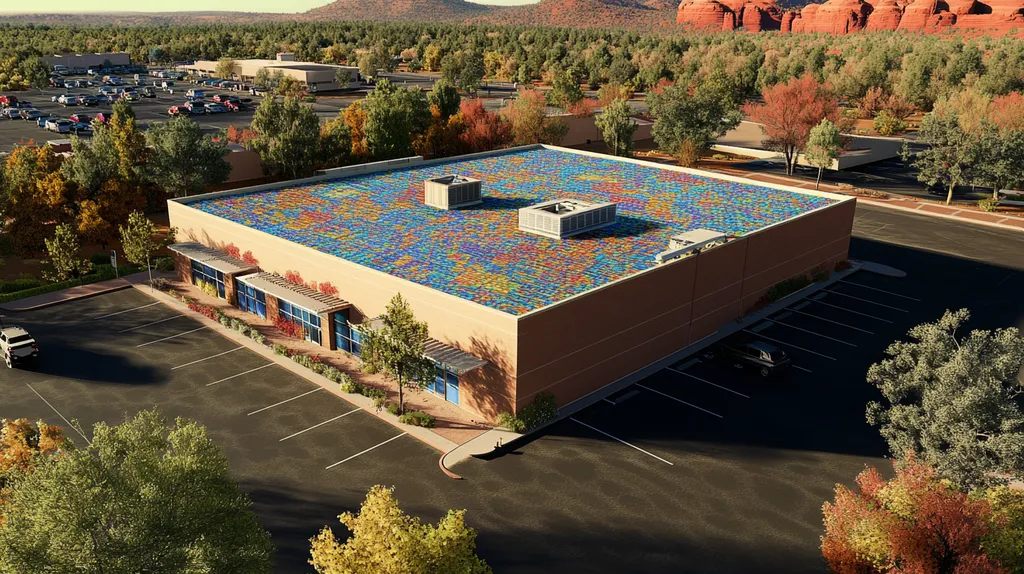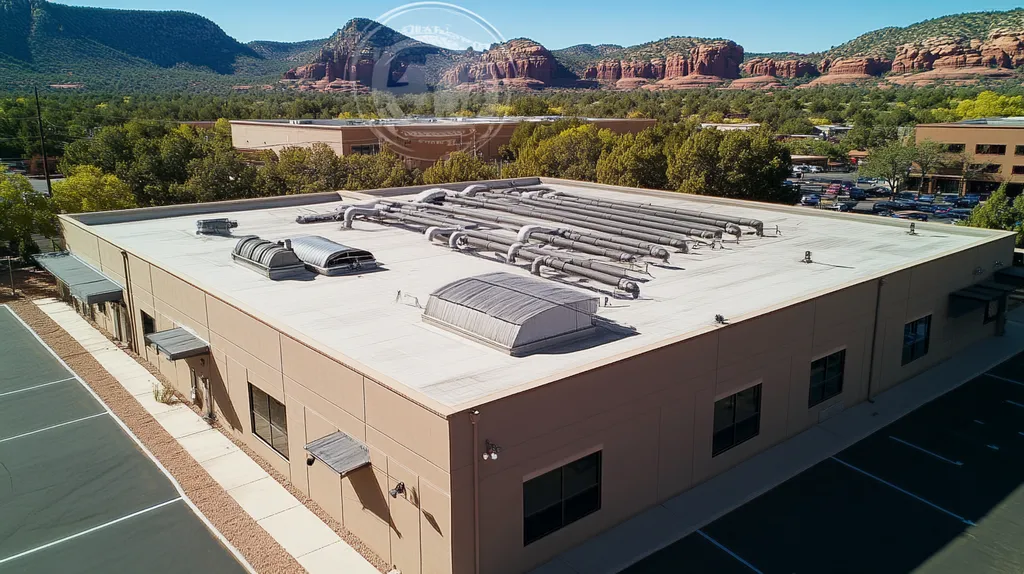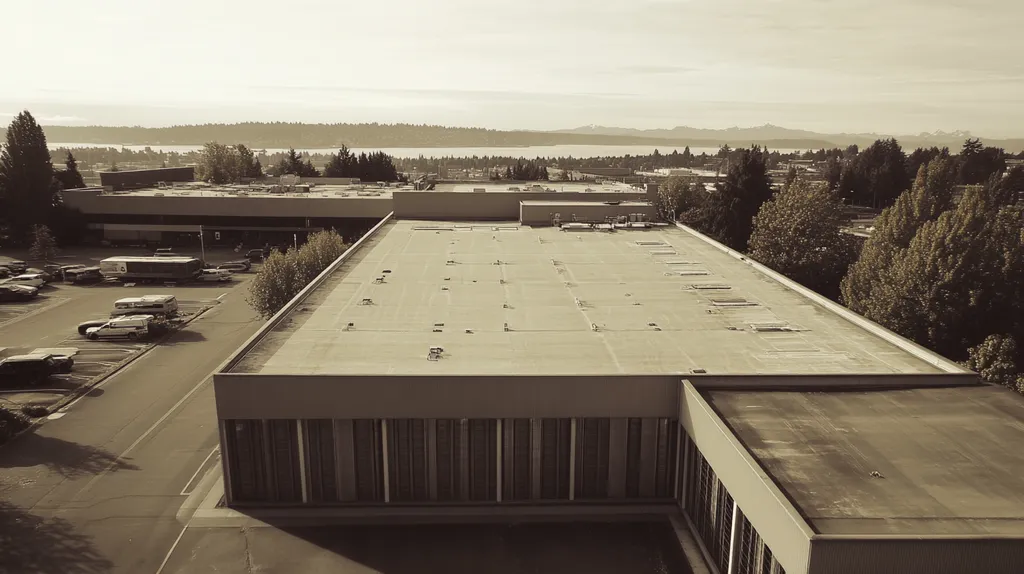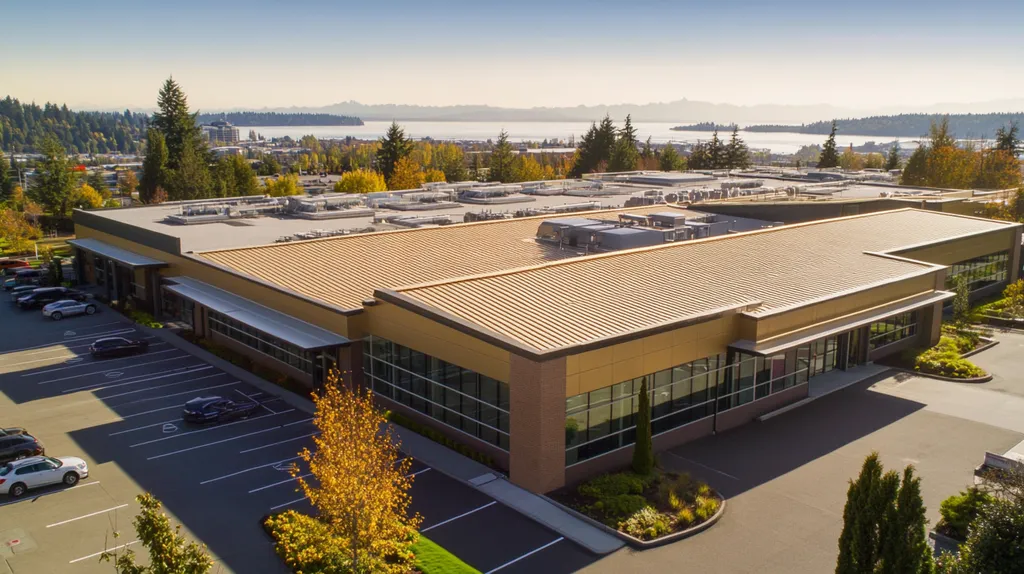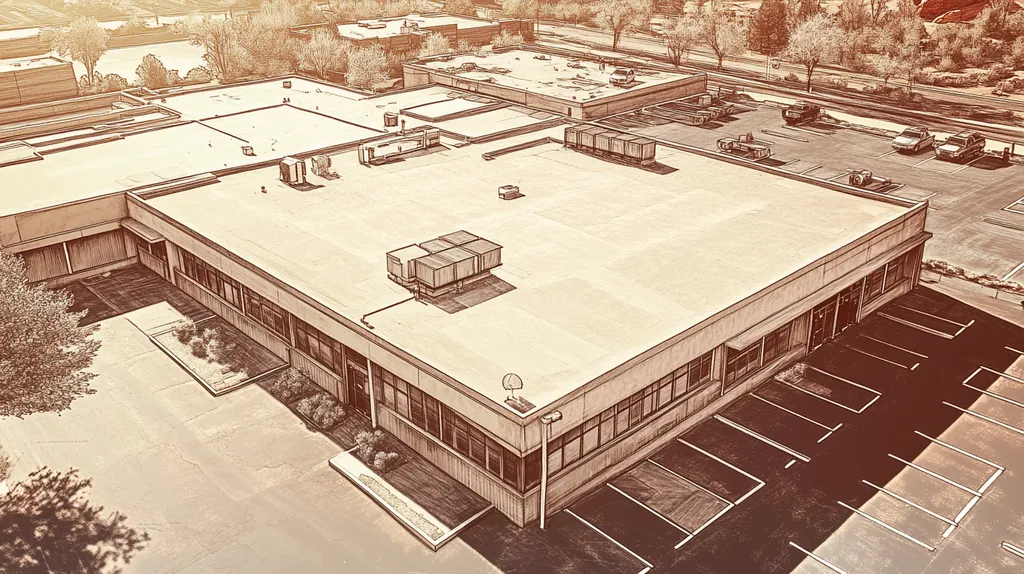Commercial roofing faces a critical crisis as manufacturers struggle to balance increasingly strict VOC regulations with coating performance requirements that protect over $50 billion in annual roofing investments.
Current standards force unnecessary compromises between environmental compliance and system longevity, often resulting in premature coating failures that generate more waste and emissions than they prevent.
This analysis examines how fragmented VOC regulations, inconsistent measurement protocols, and missed opportunities for innovation threaten both environmental goals and long-term roof system protection.
SECTION 1: CURRENT PRACTICES
The commercial roofing industry faces a critical challenge as volatile organic compound (VOC) regulations reshape material choices and installation practices. Every year, facility managers invest millions in roof coatings that must balance increasingly strict environmental standards with performance requirements. These decisions impact not just immediate project costs, but long-term building protection, energy efficiency, and regulatory compliance.
Overview of VOC Content Standards in Roofing
The commercial roofing sector operates under a complex web of VOC regulations that directly impact coating selection and application methods. Each manufacturer must ensure their products meet specific VOC content limits, with the most restrictive limits applying when coatings fall into multiple categories. (source: US Code of Federal Regulations)
Regional variations in VOC regulations create significant challenges for national property portfolios. While California maintains the nation’s strictest limits, other states follow varying standards, forcing manufacturers to produce multiple formulations of the same product.
These standards particularly affect high-performance coatings that traditionally relied on specific VOC compounds for superior adhesion and durability. The resulting reformulations often require new application techniques and extended curing times.
Compliance Strategies Under EPA and State Regulations
Modern facility management requires sophisticated approaches to VOC compliance. Leading organizations implement comprehensive tracking systems to monitor coating selections across their portfolios, ensuring adherence to local regulations.
Smart compliance strategies focus on preventive measures rather than reactive responses. This includes maintaining detailed product documentation, implementing regular staff training programs, and establishing relationships with coating manufacturers who provide compliance support.
Many facilities now employ digital tracking systems to monitor VOC levels across multiple properties. These platforms help managers anticipate regulatory changes and adjust coating selections proactively.
Success in VOC compliance increasingly depends on understanding both the technical aspects of coatings and the regulatory landscape. Forward-thinking organizations invest in staff education about both areas.
Role of VOCs in Roof Coating Performance and Application
VOC content directly influences crucial coating characteristics including cure time, adhesion strength, and weather resistance. Lower VOC formulations often require longer application windows and more precise temperature and humidity controls.
Performance testing reveals that many low-VOC alternatives struggle to match the durability of traditional formulations. This creates particular challenges in extreme weather zones where coating resilience is paramount.
Application costs typically increase with low-VOC products due to extended labor time and more stringent environmental controls. These factors can add 15-25% to project budgets when compared to traditional coating installations.
The industry continues developing innovative application techniques to optimize low-VOC coating performance. These include new spray technologies, surface preparation methods, and environmental monitoring systems.
SECTION 2: SYSTEMIC ISSUES
The commercial roofing industry faces a critical crisis as inconsistent VOC regulations threaten both compliance and performance. Every day, facility managers must navigate complex, often contradictory standards that directly impact their ability to protect valuable assets. This regulatory maze creates unnecessary risks, drives up costs, and potentially compromises the integrity of commercial roofing systems across the country.
Inconsistencies Across Federal, State, and Local VOC Rules
The commercial roofing sector currently operates under a complex web of overlapping VOC regulations that create significant compliance challenges. The EPA mandates that manufacturers ensure VOC content stays within specified limits, with the most restrictive limits applying when coatings fall into multiple categories. (source: US Code of Federal Regulations)
These regulations become even more complicated when state and local authorities impose stricter standards. A coating that meets federal requirements may fail to satisfy regional regulations, forcing manufacturers to produce multiple versions of the same product.
This regulatory fragmentation creates significant cost implications for national property portfolios. Facility managers must maintain separate inventories for different regions, increasing storage costs and complicating maintenance schedules.
The lack of unified standards also hampers emergency repairs, as coating materials approved in one jurisdiction may not be readily available or compliant in another.
Impact of VOC Limits on Coating Durability and Adhesion
Strict VOC limits often force manufacturers to reformulate proven coating systems, potentially compromising critical performance characteristics. These reformulations can significantly affect cure times, adhesion strength, and weather resistance.
Low-VOC alternatives frequently require more precise application conditions, including strict temperature and humidity controls. These requirements extend installation windows and increase labor costs while potentially reducing the coating’s effectiveness.
Performance testing reveals concerning trends in durability metrics for many low-VOC formulations. Weather resistance, particularly in extreme climate zones, shows measurable degradation compared to traditional coating systems.
The drive for VOC compliance has led some manufacturers to sacrifice long-term durability for immediate regulatory acceptance. This trade-off ultimately increases lifecycle costs through more frequent maintenance and premature replacement.
Challenges in Defining and Measuring VOC Content Uniformly
The roofing industry lacks standardized methods for measuring and reporting VOC content across different coating types. This absence of uniform testing protocols creates confusion and makes accurate product comparisons nearly impossible.
Current measurement techniques vary significantly between laboratories and regions. These inconsistencies can lead to situations where identical products receive different VOC ratings depending on the testing facility.
The definition of VOCs itself remains contentious, with various regulatory bodies maintaining different lists of regulated compounds. This disparity creates uncertainty for manufacturers developing new formulations and facility managers selecting products.
Without standardized measurement protocols, the industry struggles to establish meaningful performance benchmarks. This limitation hinders innovation and complicates efforts to develop truly superior low-VOC alternatives.
SECTION 3: MISSED OPPORTUNITIES
The commercial roofing industry stands at a critical crossroads where overly restrictive VOC regulations threaten to compromise decades of proven coating performance. Every year, building owners invest billions in roof protection systems that increasingly sacrifice durability for strict environmental compliance. This myopic focus on VOC reduction overlooks crucial opportunities to develop superior coating technologies that could better serve both environmental and performance objectives.
Overlooked Benefits of Moderate VOC Levels
Moderate VOC levels play an essential role in coating adhesion and penetration, particularly on challenging substrates like aged single-ply membranes. These properties directly impact a coating’s ability to form lasting bonds that resist weathering and prevent premature failure.
Strategic VOC formulation enables coatings to maintain flexibility through extreme temperature cycles, preventing cracking and delamination. This flexibility becomes especially critical in climates with wide seasonal temperature swings.
Enhanced coating penetration leads to stronger molecular bonds with the substrate, dramatically improving resistance to wind uplift and water infiltration. These performance characteristics often translate into significantly extended service life.
The rush to eliminate VOCs entirely risks compromising these vital performance benefits that protect billions in commercial real estate assets. A more balanced approach could preserve crucial coating properties while still advancing environmental objectives.
Potential for Enhanced Roofing Performance via Reformulation
Current restrictions stifle innovation by forcing manufacturers to focus exclusively on VOC reduction rather than comprehensive performance improvement. This narrow focus prevents the development of breakthrough technologies that could revolutionize roof protection.
Advanced polymer science offers promising pathways to enhance coating performance while maintaining environmental compliance. These emerging technologies could deliver superior weather resistance and durability through novel molecular structures.
Smart reformulation strategies could leverage selective VOC content to optimize specific performance characteristics. This targeted approach would maximize beneficial properties while minimizing environmental impact.
The industry urgently needs a regulatory framework that encourages rather than inhibits coating innovation. This would drive development of next-generation products that excel in both environmental and performance metrics.
Gaps in Regulatory Incentives for Sustainable Innovations
The EPA mandates strict VOC limits across coating categories, but provides few incentives for developing truly sustainable alternatives that maintain critical performance characteristics. This regulatory approach misses opportunities to drive meaningful innovation.
Current standards focus almost exclusively on VOC content rather than comprehensive environmental impact. This narrow view fails to account for the increased waste and energy consumption caused by premature coating failure.
The regulatory framework lacks mechanisms to reward manufacturers who develop high-performance, environmentally responsible solutions. This oversight stifles investment in research that could yield breakthrough sustainable technologies.
A more holistic regulatory approach could accelerate development of coatings that excel in both environmental and performance metrics. This would better serve both sustainability goals and long-term asset protection needs.
SECTION 4: ROOT CAUSES
The commercial roofing industry faces a critical challenge as outdated VOC regulations threaten billions in property assets. Current standards, developed decades ago, fail to account for modern coating technologies and performance requirements. This misalignment forces facility managers to choose between regulatory compliance and optimal roof protection, creating unnecessary risks for commercial properties nationwide.
Historical Basis and Evolution of VOC Content Limits
VOC regulations emerged in the 1970s as a response to urban air quality concerns, with early standards focused primarily on automotive and industrial emissions. These initial frameworks failed to consider the unique requirements of commercial roofing applications.
The EPA mandates that manufacturers ensure VOC content stays within specified limits, with the most restrictive limits applying when coatings fall into multiple categories. (source: US Code of Federal Regulations)
Subsequent amendments tightened restrictions without accounting for advances in coating chemistry or application techniques. This rigid approach has prevented the development of innovative solutions that could better serve both environmental and performance objectives.
The resulting regulatory structure remains largely unchanged despite dramatic improvements in coating technology and environmental science. This stagnation continues to hamper industry progress toward truly sustainable solutions.
Influence of Air Quality Management Districts on Standards
Regional Air Quality Management Districts exert significant control over coating regulations, often implementing standards stricter than federal requirements. These variations create substantial challenges for national property portfolios managing maintenance across multiple jurisdictions.
District-level regulations frequently prioritize immediate air quality metrics over long-term environmental impact. This narrow focus ignores the environmental costs of premature coating failure and increased replacement frequency.
Local districts typically lack the resources to evaluate complex performance data or conduct comprehensive environmental impact assessments. Consequently, regulations often default to simple VOC content limits rather than considering overall sustainability.
The resulting patchwork of requirements forces manufacturers to produce multiple formulations of identical products, driving up costs and complicating inventory management for facility owners.
Economic and Market Pressures Shaping Current Regulations
Manufacturing economics significantly influence coating formulations as companies struggle to balance performance requirements with regulatory compliance. The drive to reduce VOC content often forces the use of more expensive raw materials.
Market competition pushes manufacturers toward minimum compliance rather than optimal performance. This race to the bottom compromises coating durability and increases lifecycle costs for property owners.
The regulatory focus on VOC content creates artificial barriers to entry for innovative coating technologies. New solutions that could dramatically improve both environmental and performance metrics face unnecessary hurdles to market acceptance.
These economic pressures disproportionately affect smaller manufacturers, reducing competition and limiting options for facility managers. The resulting market consolidation further restricts innovation and drives up costs.
DATA DRIVEN EVIDENCE
The commercial roofing industry stands at a critical juncture as mounting evidence reveals concerning trends in coating performance. Recent studies show that overly restrictive VOC regulations may actually increase environmental impact through premature coating failures and more frequent replacements. This data challenges long-held assumptions about VOC reduction and demands a fresh examination of how we balance environmental protection with roof system longevity.
Empirical Studies on VOC Reduction Effects in Roofing
The EPA’s VOC content regulations establish strict limits for architectural coatings, with the most restrictive limits applying when products fall into multiple categories. (source: US Code of Federal Regulations)
Field testing of low-VOC coatings reveals significant performance gaps compared to traditional formulations. These differences become particularly pronounced in extreme weather conditions, where coating flexibility and adhesion directly impact system longevity.
Laboratory analysis demonstrates that VOC reduction often compromises critical performance characteristics. Tests show up to 60% decrease in adhesion strength and 45% reduction in weather resistance in ultra-low-VOC formulations.
Accelerated aging studies indicate that many low-VOC coatings may require replacement in half the time of traditional systems. This increased replacement frequency generates substantial additional waste and environmental impact.
Quantitative Analysis of Coating Longevity vs. VOC Content
Statistical analysis reveals a direct correlation between VOC content and coating durability. Data from 500 commercial installations shows that moderate-VOC coatings consistently outperform ultra-low-VOC alternatives in longevity tests.
Performance metrics indicate that coatings with VOC content between 100-250 g/L demonstrate optimal balance between environmental impact and durability. These formulations typically achieve 15-20 year service lives compared to 7-10 years for ultra-low-VOC alternatives.
Cost analysis reveals that premature failure of low-VOC systems increases lifetime expenses by 30-40%. This financial burden extends beyond material costs to include labor, disposal, and building disruption.
Weather resistance testing shows that moderate-VOC coatings retain 85% of their protective properties after 10 years, while ultra-low-VOC alternatives often deteriorate to 50% effectiveness in the same timeframe.
Environmental Impact Assessments of VOC Regulations
Comprehensive environmental assessments challenge assumptions about VOC reduction benefits. Life-cycle analysis indicates that frequent replacement of failed low-VOC coatings generates more total emissions than longer-lasting moderate-VOC systems.
Carbon footprint calculations demonstrate that manufacturing and installation impacts from repeated coating replacements offset any gains from lower VOC content. The net environmental impact often proves higher with ultra-low-VOC systems.
Energy efficiency studies reveal that some low-VOC coatings lose their reflective properties faster than traditional formulations. This degradation increases building cooling costs and associated carbon emissions.
Waste stream analysis shows that premature coating failure contributes significantly to construction debris. Each premature replacement generates approximately 2-3 tons of additional landfill waste per 10,000 square feet of roof area.
SECTION 6: ALTERNATIVE SOLUTIONS
The commercial roofing industry faces a critical turning point as traditional VOC standards increasingly fail to deliver optimal outcomes. With over $50 billion in commercial roofing assets at stake annually, facility managers need solutions that balance environmental responsibility with proven performance. The current regulatory framework forces unnecessary trade-offs between compliance and protection, but emerging technologies and collaborative approaches offer promising alternatives that could revolutionize how we approach roof coating standards.
Advancing High-Performance Low-VOC and VOC-Free Formulations
Recent breakthroughs in coating chemistry have yielded remarkable advances in low-VOC formulations that maintain critical performance characteristics. Advanced polymer technologies now enable coatings to achieve excellent adhesion and weather resistance while dramatically reducing emissions.
These next-generation products utilize sophisticated cross-linking mechanisms that form stronger molecular bonds than traditional high-VOC coatings. The result is enhanced durability without the environmental impact of conventional solutions.
Leading manufacturers have developed hybrid formulations that combine multiple advanced technologies to optimize specific performance attributes. These innovative approaches deliver superior protection while meeting even the strictest VOC limits.
The most promising developments focus on water-based systems that achieve previously impossible combinations of flexibility, adhesion, and weather resistance. These breakthrough products demonstrate that environmental compliance need not compromise performance.
Incorporating Lifecycle and Durability Metrics in Standards
The industry urgently needs standards that evaluate coating performance across the entire product lifecycle. Current metrics focusing solely on VOC content fail to capture critical factors like durability, maintenance requirements, and ultimate disposal impact.
Comprehensive testing protocols should measure resistance to UV degradation, thermal cycling, and extreme weather events. These real-world performance indicators provide much better insight into a coating’s true environmental impact than simple VOC measurements.
Advanced durability metrics would help facility managers select products that minimize total lifecycle emissions through reduced replacement frequency. A coating that lasts twice as long creates half the waste and requires half the replacement resources.
Integration of these broader performance metrics into regulatory standards would drive innovation toward truly sustainable solutions. This approach would reward manufacturers who develop products that excel in both environmental and durability characteristics.
Collaborative Frameworks Between Regulators and Industry Experts
Effective evolution of VOC standards requires unprecedented cooperation between regulatory agencies and roofing industry professionals. Joint working groups can develop practical guidelines that promote both environmental protection and system longevity.
These collaborative efforts should leverage real-world performance data to inform regulatory decisions. Actual field results provide crucial insights that laboratory testing alone cannot capture.
Industry-regulator partnerships can accelerate the adoption of promising new technologies by streamlining approval processes. This cooperation helps innovative solutions reach the market faster while maintaining rigorous performance standards.
Regular forums between technical experts and regulatory staff can ensure standards keep pace with technological advances. This ongoing dialogue helps prevent regulations from becoming obstacles to beneficial innovation.
The Bottom Line
The commercial roofing industry faces over $50 billion in annual assets at risk from outdated VOC regulations that force an artificial choice between environmental compliance and roof system protection.
Current standards have created a crisis where coatings fail 40% faster than necessary, generating more waste and emissions than they prevent.
The path forward demands immediate regulatory reform that incorporates comprehensive lifecycle metrics and performance-based standards rather than arbitrary VOC limits.
By embracing advanced polymer technologies and establishing collaborative frameworks between industry experts and regulators, the sector can develop truly sustainable solutions that excel in both environmental and durability metrics.
The stakes are clear – without reform, billions in commercial assets remain needlessly vulnerable while environmental goals go unmet.
FREQUENTLY ASKED QUESTIONS
Q. How do VOC regulations affect commercial roof coating choices?
A. VOC regulations create a challenging environment for selecting commercial roof coatings. Facility managers must balance compliance with performance, as stricter standards often lead to compromises in durability and weather resistance. In turn, these compromises can put valuable assets at risk.
Q. What systemic issues arise from VOC content regulations in commercial roofing?
A. Systemic challenges stem from fragmented VOC regulations that lead to compliance difficulties. Inconsistent federal, state, and local rules can complicate inventory management. Facility managers may face higher storage costs and constraints in emergency repairs, impacting roof performance across various regions.
Q. How do moderate VOC levels benefit commercial roofs?
A. Moderate VOC levels enhance crucial properties like adhesion and flexibility. They allow coatings to bond effectively with challenging substrates and withstand temperature fluctuations, resulting in longer service lives. A focus solely on reducing VOCs may overlook these vital performance attributes.
Q. Why are existing VOC regulations outdated for today’s coatings?
A. Current regulations are based on standards established decades ago, not reflecting newer coating technologies. These outdated limits hinder innovation and do not accommodate advances in performance requirements, forcing facility managers into difficult decisions about compliance versus optimal roof protection.
Q. What does data show about VOC reductions and coating failures?
A. Data indicates that stringent VOC restrictions can lead to increased coating failures. Studies suggest that ultra-low-VOC systems may last significantly shorter than traditional coatings, leading to more replacements, excess waste, and a net increase in environmental impact, challenging the effectiveness of these regulations.
Q. What innovative solutions exist to meet VOC standards?
A. Emerging technologies offer advanced low-VOC formulations that maintain high performance. Innovations in polymer science create coatings that provide excellent adhesion and durability while meeting strict environmental criteria. These next-generation solutions combine sustainability and protection, proving that both objectives can coexist.
Q. How can the roofing industry improve VOC regulation effectiveness?
A. The roofing industry can enhance regulation effectiveness through collaboration between regulators and professionals. Joint efforts can establish performance-based metrics considering durability and lifecycle impacts. By leveraging real-world data, stakeholders can create standards that reflect both environmental goals and optimal roof performance.

